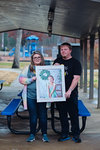
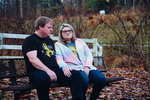
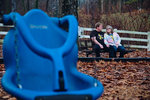
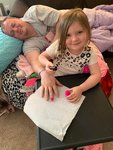

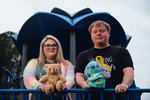
SILER CITY — Those who knew Kenzie Wrenn Scoggins knew her as unconditional, pure love.
At 4 years old, Kenzie was vibrant, cheeky and affectionate; she was known to reliably crack up at hearing a curse word just as easily as she would earnestly tell those around her that they looked beautiful on their worst days.
Almost a year ago today, Kenzie was diagnosed with an aggressive childhood brain tumor called diffuse intrinsic pontine glioma, or DIPG. DIPG spreads throughout a part of the brain stem called the pons, making it inoperable; most patients are given a survival range of eight to 11 months.
Kenzie died from the disease on Sept. 18, at the age of 5, following months of radiation therapy and treatments.
On Saturday, Dec. 17, the towns of Siler City, where Kenzie lived, and Pittsboro, as well as Chatham County, will mark what would have been Kenzie’s 6th birthday with “Bushel & A Peck Day” — named after a song she would sing along with her mother, which has become emblematic of the love the child shared with those close to her.
In her absence, the Scogginses and Kenzie’s loved ones are continuing to honor her memory and carry on her legacy.
Between 200 to 400 children are diagnosed with DIPG every year in the United States. The rate of survival is low; there’s just a 10% chance of surviving beyond two years and a 2% chance of surviving beyond five years following a patient’s diagnosis.
For Kenzie’s mother, Meghan Scoggins, 32, hearing their doctor at UNC Children’s Hospital give a prognosis containing the words “inoperable” and “no cure” to her daughter, who had not yet started kindergarten, is something she says she’ll never forget.
A few months prior, Meghan said she noticed her otherwise playful and outgoing child experiencing some unusual health issues — wobbliness, shifty eyes, headaches. She saw a pediatrician who she said dismissed her concerns at the time, and had made plans to take Kenzie to an ophthalmologist.
They never made it to that appointment.
Just 45 minutes after dropping Kenzie off at her daycare on Dec. 8, 2021, and asking staff to keep an eye on her, Meghan received a text from one of the preschool teachers. Something wasn’t right, she was told. Meghan picked up Kenzie and quickly made her way to the emergency room at UNC Hospitals, where they were met by Dusty, Kenzie’s father. An MRI eventually confirmed the worst.
In that moment, Meghan said her whole world stopped.
“I remember crying so hard I couldn’t even stand up,” she recalled.
“‘Your options are to do radiation and go home [or] to do radiation and to pick a trial,’” Meghan said doctors told her. “‘But there is currently no cure. And this is probably going to take your daughter.’”
The first three days after Kenzie’s diagnosis, Meghan said she didn’t eat or drink, and barely slept. In a search for answers and support, she started finding others in the DIPG community, connecting with parents and the ChadTough Defeat DIPG Foundation, a nonprofit that the Scogginses eventually became family partners with.
Finding that network of organizations and families of other DIPG patients was incredibly meaningful for the Scogginses. Shortly after Kenzie’s 5th birthday, Meghan created a Facebook page to share updates about her daughter’s journey and progress. The page — “Kenzie’s Bushel & a Peck” — now has more than 5,000 followers, and a quick scroll through it reveals messages of support and faith from people across the world.
“By the end of this journey, we have people from California to Canada, Mexico, people in Ireland and Scotland, in Africa, who know about my child, and who have prayed for her, sent good vibes, sent mail,” Meghan said.
The DIPG community is a tight-knit one.
“We all say that it’s a group you don’t want to be in, but you’re so thankful to have it,” Meghan said. “Because it is needed, sadly.”
For DIPG patients, radiation therapy is the main form of treatment; patients often see a reduction in the size of the tumor and in the pressure applied on the brain stem. However, responses to the treatment are brief — in almost all cases, the tumor begins to grow back after six to 12 months, according to the DIPG Resource Network. Given the limited options for those with DIPG, patients may explore clinical trials in hopes of prolonging life.
After considering their options, Meghan and Dusty made the decision to enroll Kenzie in a CAR-T cell trial in California at Lucile Packard Children’s Hospital at Stanford. The phase one clinical trial takes a patient’s T cells — a type of white blood cell and a major component of the immune system — and engineers them to target an antigen called GD2 that is expressed on gliomas with the H3K27M mutation.
“We decided that we were going to fight,” Meghan said. “The best that we could for as long as we could, just to give her as much of a life and as much of a chance as she could.”
Kenzie loved most things that preschoolers tend to love: all things Disney, giving other people makeovers, having tea parties, fart jokes. In March, the whole family was able to travel to Orlando to visit theme parks through the Make-A-Wish Foundation, an experience Meghan and Dusty say they’re eternally grateful to have shared with Kenzie.
She enjoyed painting other people’s nails and doing hair; her dad would often oblige her with both, lying on the ground on his stomach so she could sit up on his back to brush and style his hair. Meghan called Kenzie their “tie-dye hippie chick.” At her funeral, attendees were encouraged to wear blue, her favorite color, and other bright hues.
“Kenzie was rainbows and sunshine and sass,” Meghan said.
That sass and mischevious nature shone through in a number of ways. Sometimes, Kenzie would play tricks on her nurses and doctors at Stanford, rolling her eyes in the back of her head and falling over, scaring “the bejesus” out of everyone, Meghan said.
Dr. Jasia Mahdi is a child neurologist and neuro-oncologist who cared for Kenzie during her time at Stanford. For the several weeks Kenzie was in California receiving treatment in the early summer of 2022, Dr. Mahdi spent every day with her.
“I distinctly remember the day [she came in for her consent visit] because she just kind of walks in the room and brightens the whole place up,” Dr. Mahdi said. “She was like a ball of energy and was very excited, and very warm. And you could tell how loving and effusive of a spirit she had, so within a couple of minutes she grabbed my hand and we were wandering around the clinic together.”
Quickly, staff came to realize that Kenzie found curse words hilarious, and sometimes they’d let a curse word slip just to get her to laugh, Dr. Mahdi recalls. She’d giggle with her whole body, her belly shaking up and down with laughter.
By the time Kenzie had arrived at Stanford, her tumor had significantly grown, so she was treated on a compassionate basis. While she responded well initially to the therapy, her tumor eventually grew to the point where it would no longer be effective or safe for her to continue receiving treatment. Shortly afterward, Meghan and Dusty brought Kenzie back to North Carolina, where she would remain on hospice care until her passing in September.
When it came time for Kenzie to leave Stanford to go home, it was an emotional departure. Everyone cried, including Kenzie, Meghan said. But that’s just how people — medical staff, teachers, family and even strangers — tended to respond to her.
Christy Welch, her teacher at Write Beginnings Christian Preschool in Siler City, described Kenzie as a “livewire,” with a sweet nature and tenacious spirit all in one.
“[She] definitely would make you feel like a million bucks whenever you came in and you were you were rushed from your morning travels, and she would say to you that you looked beautiful and that your hair was beautiful,” Welch laughed. “And you’re like, ‘Well, I don’t know what you’re looking at.’”
After her diagnosis, Kenzie only went to her preschool three times. But her fellow classmates and teachers missed her dearly, Welch noted, with the preschool being like a family.
“She’s definitely left that thumbprint upon all of us and changed us all,” she said.
In just one conversation, it’s overwhelmingly evident the kind of love Meghan has for her child. She is both fiercely passionate about increasing awareness of DIPG and federal funding for childhood cancer, and incredibly transparent and vulnerable about the most traumatic event of her life, laughing and crying over memories of her little girl.
Now, Meghan sees it as part of her duty to continue to raise awareness of DIPG, posting frequently on Kenzie’s Facebook page about her experiences of grief and sharing fundraisers for families experiencing DIPG and foundations like NoahBRAVE, ChadTough and Tough2gether Against DIPG.
“It is my real life, my everyday life that I have to live with,” she said. “And so that’s why I do it, so that one day, another mother won’t have to bury their child. Another father, another grandmother, or grandfather, aunt, uncle, cousin, won’t have to be where we are. Because, now, my daughter only got five years, and look at how many people she’s touched.”
Dr. Mahdi notes that though DIPG research has seen significant development over the past decade — driven by pioneers like Stanford Medicine’s Dr. Michelle Monje — there is still much work to be done to fine tune treatments and to better understand the tumor and its microenvironment.
In 2021, cancer research received around $7,362,000,000 in funding from the National Institutes of Health, while pediatric cancer research received around $664,000,000. To Meghan, the current federal funding dollars aren’t enough.
Similarly, naming DIPG for what it is has been important to Meghan. Shortly after Kenzie’s passing, Meghan pushed to have Kenzie’s death certificate corrected from listing the cause as “malignant neoplasm brain” to “malignant diffuse intrinsic pontine glioma.”
She says she doesn’t like to refer to DIPG as a “rare” form of cancer because, the way she sees it, too many children have died for it to be rare. Brain tumors are the most common cause of cancer-related death in children under 15, according to the DIPG Resource Network, with DIPG being the most common brain stem tumor in children.
“DIPG murdered my child,” Meghan said. “And if you’re a murderer, you are going to be held accountable, and I needed DIPG to be held accountable, because that is what took her.”
Technically, Kara Knight is Kenzie’s cousin, but to the little girl, she was her “Aunt Kara.” They shared a close relationship; Knight and Dusty grew up together, much like siblings. Knight has a son similar in age to Kenzie, and when Kenzie moved to at-home hospice, Knight stayed with Meghan and Dusty and helped to care for her.
As Kenzie’s 6th birthday approaches, Knight said it’s been especially challenging for the family.
To Kenzie, family was everything, whether it was making Valentine’s cards for her relatives or crying on FaceTime when she was in California because she just wanted to be home with them in Siler City. Many of her loved ones gathered the day after Thanksgiving by her gravesite to decorate a Christmas tree with ornaments stuck with messages for Kenzie and photos of her.
One of the ways Knight hopes to now honor her niece’s legacy is through sharing stories and memories of her. When she learned that Siler City, Pittsboro and the county will be honoring Kenzie through a Bushel & A Peck Day, Knight was deeply touched.
“It means the world because a lot of bad things happen in this world, and you lose a lot of faith,” Knight said. “And when something so horrible happens — and this has been the worst thing that’s ever happened to me, and I’m sure most of our family, it’s been terrible — so you lose a lot of faith and it’s hard to see the positives.
“And so when these little things happen, they’re [actually] big things — having someone interested and listening to your stories. And I talk about Kenzie all the time, and I keep waiting for someone to be like, ‘Alright, enough,’” she said with a laugh.
Kenzie loved arts and crafts, and even once told her teacher that she wanted to be a painter when she grew up. The Scogginses tell Kenzie’s cousins now that when they see a tie-dye sky full of pinks and blues and purples, Kenzie is painting the sky. The day that her family gathered to decorate her Christmas tree, the sky was rich with color and a heart-shaped cloud hung overhead.
For Meghan, the grief she’s experienced since Kenzie’s death has ebbed and flowed. She describes it like a train — it doesn’t stop, no matter how hard one tries.
“Because if there’s one thing about grief is it’s going to come out, it’s going to come out in one form or another,” she said. “And if you hold it in for too long, it will leave you in a cemetery at 9 o’clock at night screaming at the top of your lungs because you are so angry and so tired of feeling sad all the time. So whatever way you can, get it out, whether it be talking, helping other people, crying, watching videos.”
In many ways, Kenzie was a miracle, according to her family. She was born six weeks prematurely, spending a week in the NICU before coming home on Christmas Eve.
“She was our little miracle baby,” Meghan said.
In her wake, the miracle of her existence is something that her loved ones continue to marvel in every day.
In her memory, Kenzie’s preschool is holding a “Love Like Kenzie Day” fundraiser for her birthday, which they plan to make an annual tradition. This year, the preschool is raising donations for a child in need who was in Kenzie’s class to celebrate Christmas. The Disney song, “Waiting on a Miracle,” was played at her memorial service. And after her passing, the Scogginses donated Kenzie’s brain to Stanford; her cultures are now growing, contributing to much-needed research for DIPG.
“I just feel like she gave the world the miracle that she didn’t get,” Meghan said.
For those looking to support DIPG research, visit Kenzie’s family partner page with ChadTough Defeat DIPG Foundation, the NoahBRAVE Foundation, and Tough2gether Against DIPG. To contribute to the Write Beginnings Christian Preschool fundraiser, contact Christy Welch at (919) 799-9615.
Reporter Maydha Devarajan can be reached at mdevarajan@chathamnr.com and on Twitter @maydhadevarajan.